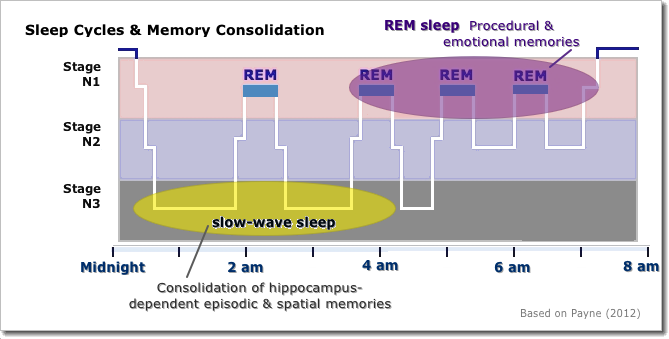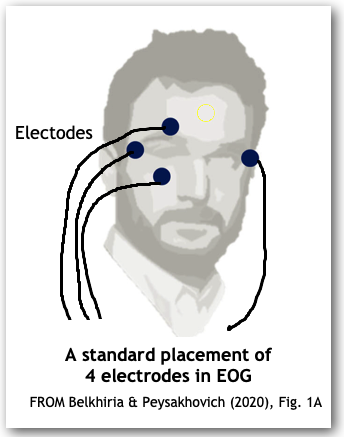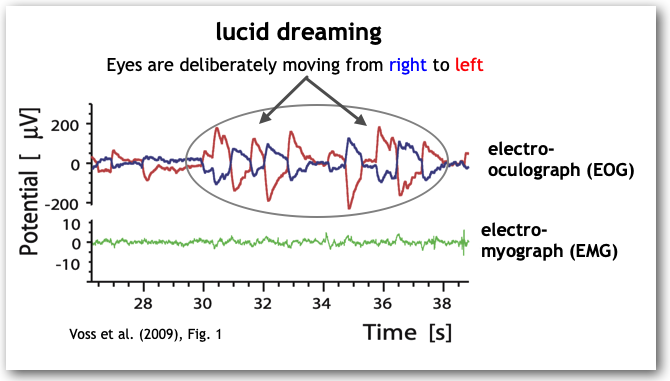March 8, 2025
![[Brain Image]](../graphics/head_space.gif)
PSY 340 Brain and Behavior
Class 24: Why Sleep? Why REM? Why Dreams?
|
March 8, 2025 |
PSY 340 Brain and Behavior Class 24: Why Sleep? Why REM? Why Dreams? |
|
A. Functions of Sleep
Why do we sleep? Short answer: we do not know (but we are beginning to figure out some answers)
- Note, too, that any theory of sleep in humans needs to consider why other animals sleep!
Some potential answers (see excellent Mignot [2008] & Krueger et al [2015] articles referenced below). Here are three suggestions which have received significant attention:
1. Sleep and Energy Conservation
- Note that even single-cell organisms like bacteria have a circadian rhythm with periods of higher activity and relative rest.
- Since all living organisms with a neural & glial system sleep (Krueger et al, 2015), what might evolution have been doing to promote sleep? Saving energy particularly at times of inefficiency (e.g., human vision is much better in day whereas other predators' vision is better at night)
- Body temperature goes down (~1-2º C) & thus lower use of calories
- Body is still and not moving much & thus more energy savings
- Analogous to Sleep: Hibernation = body temp drops to just above freezing, brain activity lowers to almost nothing
- Various smaller mammals (bats, ground squirrels, hamsters) experience "deep hibernation" (e.g., body temperature drops from 32ºC/90ºF or more to near freezing while bears lower their body temperature by 8-12ºF--much less than smaller mammals). Note that most squirrels do NOT hibernate.
- Most hibernating animals come out of hibernation every few days for a few hours. They mostly sleep at these points.
- Helps retard aging process & protects against infection & trauma. (A study in March 2012 found that wounds on black bears during the winter tend to heal without scars! (Iaizzo et al. 2012).)
- Alternative sleep strategies in animals (see diagram above)
- Little sleep in cows, horses, sheep, goats
- Much sleep in cats, bats
- Moderate sleep in humans, rabbits, foxes
- Dolphins & some other animals have one hemisphere asleep and the other awake
- Migratory birds during migration period appear to have a suppressed need for sleep
2. Sleep and Memory

- Studies regularly find that sleep is a time when long-term memories are strengthened (consolidation).
- "...much of the legwork of memory is done during other phases of sleep [i.e., during NREM sleep] — helping the brain shuffle memories around, reactivating them in the hippocampus, editing them in areas such as the prefrontal cortex, and returning them to areas of the cortex nearer the hippocampus for longer-term storage and retrieval" (Smith, 2013, p. S4, boldface added)
- Various studies of multiple species of animals find that patterns of activation of the hippocampus during the day seem to be "replayed" during sleep. This suggests that one role of sleep may be to go through the experiences of the past day and "weed out" or otherwise discard unneeded connections.
- Sleeping after learning something usually results in memory gain upon awakening
- Research (Payne, 2012) suggests that memory consolidation takes place during different points of sleep (see diagram above):
- Hippocampus-dependent episodic & spatial memory consolidation associated with SWS (slow-wave or non-REM sleep) in the first half of the night. Also, verbal learning (e.g., memorizing lists of words)
- Procedural (motor skills) and emotional memory consolidation associated with REM sleep in the second half of the night
![[Spine formation]](../graphics/Sleep%20deprivation%20Yang%20et%20al%202014.png)
- Research in 2014 found evidence in mice that non-REM sleep is associated with the growth of new dendritic spines, that is, new synapses form, after the animal learns a new skill (Costandi, 2014; Yang et al, 2014; see diagrams above.)
- Stage N2 sleep spindles (12-14 Hz) are associated with communication between thalamus & cerebral cortex and with new learning.
- Amount of spindle activity correlates 0.7 with nonverbal IQ (i.e., explains 49% of variation!)
3. Sleep and Toxic Waste Removal (new: not in book)
Glymphatic System: Researchers at the University of Rochester School of Medicine led by Dr. Maiken Nedergaard discovered a kind of "plumbing system" for the brain which they labeled as the "glymphatic" system (Illiff et al., 2012).
- The brain does not have the usual lymphatic system of the rest of the body.
- The brain does have a system by which cerebrospinal fluid (CSF) is channeled along the very tiny penetrating arteries of the brain and, then, flows through the brain tissue to be collected by the veins.
Toxic Waste Removal During Sleep: In 2013, the same research team reported that, during sleep, the astrocytes in the brain of mice shrunk in size and created about 60% more space between themselves (i.e.,, in the interstitial space; Xie et al., 2013). This allowed much easier flow of various metabolic waste products (particularly Amyloid-β) to be cleared from the brain. The flow was about 10 times higher than during the awake period. When the mice were awake, the astrocytes resumed their usual size.
- These findings suggest that one of the functions of sleep in the mammalian brain is to permit the flushing or clearance from the central nervous system of toxic waste products which accumulate during waking hours.
- More recent research (Haugland et al. 2025) identifies that the mechanism by which this process occurs involves the neurotransmitter norepinepherine. As summarized by Barrioneuvo (2025):
"The brainstem releases tiny waves of norepinephrine once every 50 seconds during deep sleep. Those waves get blood vessels to contract and generate slow pulsations called vasomotions to create a rhythmic flow, which encourages the surrounding fluid to take the waste away." (emphases added)
B. Functions of REM Sleep
- There is a higher percentage of REM sleep in organisms that sleep longer, e.g.,
- As noted above, REM may help in memory storage
C. Biological Perspectives on Dreaming
- Complex dreaming develops as we get older (Domhoff, 2001)
- dreams of children < 5 yo are bland and static & children < 10 yo report dreams only in about 20-30% of REM sleep
- adolescent/adult dreams are more dynamic & complex & dreams are reported in > 80% of REM sleep of adults
NOTE: we normally do not remember any NREM dreams. We know about these from lab research when participants in NREM sleep are awakened and asked to report if/what they might have been dreaming.
- REM dreaming is different than NREM dreaming (not in book; Kandel et al., 2013)
- REM dreams: long, highly visual, often emotional, not often related to recent life experience
- NREM dreams: short, non-visual, "conceptual" or thought-like, often related to recent life experiences
There are many different theories about why we dream and, indeed, new theories are being proposed as we learn more and more about the functioning of the central nervous system. Here are some of the more important historical and biological theories about dreaming:
- There is no theory of dreaming which is now currently accepted by most psychologists.
1. Freud's Psychoanalytic Theory (published in 1899 but dated 1900, The Interpretation of Dreams)
- All dreams are forms of wish fulfillment and rest upon two different mental processes
- An unconscious process constructs a wish (related to issues of sexuality and/or aggression), and
- A censorship process distorts the expression of the wish by using symbols and other means to keep the ultimate wish hidden.
- All dreams, though, do reflect some areas of experience from recent daily life
- As a result of these interacting processes, all dreams are comprised of two types of content
- The manifest context of the dream is whatever the person remembers of the dream's narrative when the person awakes, and
- The latent content of the dream is the underlying meaning of the dream which involves the actual but unconscious wish expressed by the dream.
- Understanding the latent content of dream requires a process of interpretation in which the person with the dream works with a psychoanalyst to come to understand the latent content.
2a. Activation-Synthesis Hypothesis (J. Allan Hobson's initial thesis in 1977)
2b. Protoconsciousness Theory (J. Allan Hobson's more recent thesis, 2009; not in text)
- Activation: During REM sleep, different brain areas become active under stimulation from the brain stem (that is, the pons). These areas involve circuits related to emotion, memories, and sensations. Occasionally, sounds in the environment of the sleeper also activate the brain.
- Synthesis: The cortex of the brain creates a story to make sense of this random activity.
- "Brain activation in sleep allows the development and maintenance of circuits necessary for higher brain functions, including consciousness"
- Note that in dreams, "we are always ourselves; we sense, we act and we feel vividly in an entirely fictive world of the brain's devising"
- "REM sleep may constitute a 'protoconscious' state, providing a virtual reality model of the world that is of functional use to the development and maintenance of waking [or secondary] consciousness"
- "According to the protoconsciousness hypothesis, the brain is genetically equipped with a model that generates [creates] a virtual reality during sleep and is entrained [i.e., synchronized] by sensory input during waking. The basic idea developed here is that sleep is essential to optimize this generative model for Bayes-optimal learning and inference during wakefulness" [that is, improving the ability of the brain to use predictive models as a person experiences the world consciously] (Hobson & Friston, 2012, p. 83. Comments in brackets [] are my explanation for what parts of this quote means.]
3. Neurocognitive Theory of Dreaming (William Domhoff, 2001, 2017, 2019; not in text)
- There is an underlying neural substrate for dreaming, i.e., the default mode network (DMN). Dreaming is, in many ways, similar to what goes on when someone is awake but daydreaming. The mind drifts from one image to another.
- Dream abilities develop from early childhood into adulthood (note, BTW, that the DMN itself undergoes maturation during childhood and early adolescence [8 to 15 years old] as we saw a few weeks ago). The cognitive abilities of young children (e.g., to understand and create narratives/stories) undergo development. Note that this is the same developmental period in which dreams become much more complex.
- The content of adult dreams reflect many of the real-life aspects of an individual, that is, most dreams have to do with what is personal in our lives (rather than about politics, economics, etc.). 70% of all dreams are directly personal. Note that the DMN is particularly involved in our sense of self.
- There is no adaptive function to dreaming in an evolutionary sense; rather dreaming is a by-product of the mechanisms necessary for being awake or conscious which do have an adaptive function.
Lucid Dreaming [Not in book]
Lucid dreaming is "a hybrid state of consciousness with definable and measurable differences from waking and from REM sleep, particularly in frontal areas" (Voss et al., 2009, Abstract].
- "Lucid dreaming refers to the phenomenon of becoming aware of the fact that one is dreaming during ongoing sleep... During lucid dreams individuals can be physiologically asleep while at the same time aware that they are dreaming, able to intentionally perform diverse actions, and in some cases remember their waking life" (Baird et al., 2019, p. 305).
- Lucid dreaming has been reported throughout human history. It began to become the subject of scientific study in the early 1900s and has been extensively researched since the 1980s.
- About 55% of all adults report having had at least one lucid dream and 23% report having regular lucid dreams, that is, at least once a month (Aspy, 2020).
- Training for Lucid Dreaming (Aspy, 2020). Multiple studies have shown that “subjects can be trained to become lucid via pre-sleep autosuggestion. Subjects often succeed in becoming lucid when they tell themselves, before going to sleep, to recognize that they are dreaming by noticing the bizarre events of the dream. An experimental advantage is that subjects can signal that they have become lucid by making a sequence of voluntary eye movements. In combination with retrospective reports confirming that lucidity was attained and that the eye movement signals were executed, these voluntary eye movements can be used as behavioral indication of lucidity in the sleeping, dreaming subject, as evidenced by EEG and EMG tracings of sleep” (Voss et al., 2009, p. 1191).


- In the diagrams above, you can see where electrodes are placed and the tracing of the movement of a subject's eyes from right to left (and in reverse, left to right) during a lucid dream as measured by an electro-oculograph (EOG). In research studies, participants are told to make such movements when they become aware that they are having a lucid dream. This allows the researchers to mark a period of lucidity during dreams. Note that the degree of movement of the eyes is significantly greater than seen in persons who are dreaming in REM sleep.
- The current physiological description of lucid dreaming indicates that it represents an intermediate state of consciousness between REM sleep (that usually involves a great deal of posterior cortical activity) and wakefulness (that involves significant activity of the frontal areas of the brain).
References
Aspy, D. J. (2020). Findings from the International Lucid Dream Induction Study. Frontiers in Psychology, 11, 1746. https://doi.org/10.3389/fpsyg.2020.01 2746
Baird, B., Mota-Rolim, S. A., & Dresler, M. (2019). The cognitive neuroscience of lucid dreaming. Neuroscience and Biobehavioral Reviews, 100, 305-323. https://doi.org/10.1016/j.neubiorev.2019.03.008
Barrioneuvo, K. L. (2025, January 8). Molecule gives brain a deep cleaning during sleep. Courthouse News Service [Online]. https://www.courthousenews.com/molecule-gives-brain-a-deep-cleaning-during-deep-sleep/
Belkhiria, C., & Peysakhovich, B. (2020). Electro-encephalography and electro-oculography in aeronautics: A review over the last decade (2010–2020). Frontiers in Neuroergonomics, 1, Article 606719. https://doi.org/10.3389/fnrgo.2020.606719
Domhoff, G. W. (2001). A new neurocognitive theory of dreams. Dreaming, 11, 13-33. https://doi.org/10.1023/A:1009464416649
Domhoff, G. W. (2017). The emergence of dreaming: Mind-wandering, embodied simulation, and the default network. New York: Oxford University Press.
Domhoff, G. W. (2019). The neurocognitive theory of dreams at age 20: An assessment and a comparison with four other theories of dreaming. Dreaming, 29(4), 265-302. https://dx.doi.org/10.1037/drm0000119
Costandi, M. (2014, June 11). Sleep may help memories form by promoting new synapses. The Guardian.com. Retrieved from http://www.theguardian.com/science/neurophilosophy/2014/jun/09/sleep-dendritic-spines-memory/
Haugland, N. L., Andersen, M. … Nedergaard, M. (2025). Norepinephrine-mediated slow vasomotion drives glymphatic clearance during sleep. Cell, 188(3), 606-622.e17. https://doi.org/10.1016/j.cell.2024.11.027
Hobson, J. A. (2009). REM sleep and dreaming: Towards a theory of protoconsciousness. Nature Reviews Neuroscience, 10, 803-813. https://doi.org/10.1038/nrn2716
Hobson, J. A., & Friston, K. J. (2012) Waking and dreaming consciousness: Neurobiological and functional considerations. Progress in Neurobiology, 98, 82-98. https://doi.org/10.1016/j.pneurobio.2012.05.003
Holzinger, B., LaBerge, S. & Levitan, L. (2006). Psychophysiological correlates of lucid dreaming. Dreaming, 16(2), 88–95. https://doi.org/10.1037/1053-0797.16.2.88
Iaizzo, P. A., Laske, T. G., Harlow, H. J., McClay, C. B., & Garshelis, D. L. (2012). Wound healing during hibernation by black bears (Ursus americanus) in the wild - Elicitation of reduced scar formation. Intergrative Zoology, 7(1), 48-60. https://doi.org/10.1111/j.1749-4877.2011.00280.x
Illiff, J. J., et al. (2012). A paravascular pathway facilitates CSF flow through the brain parenchyma and the clearance of interstitial solutes, including Amyloid B. Science Translational Medicine, 4(147), Article 147ra111. https://doi.org/10.1126/scitranslmed.3003748
Kandel, E. R., Schwartz, J. H., et al. (Eds.). (2012). Sleeping and dreaming. In Principles of neural science (5th ed.). New York, NY: McGraw-Hill. http://0-neurology.mhmedical.com.library.lemoyne.edu/content.aspx?bookid=1049§ionid=59138683
Krueger, J. M., Frank, M. C., Wisor, J. P., & Roy, S. (2015). Sleep function: Toward elucidating an enigma. Sleep Medicine Reviews. http://dx.doi.org/10.1016/j.smrv.2015.08.005
Mignot, E. (2008). Why we sleep: The temporal organization of recovery. PLoS Biology, 6(4), e106. https://doi.org/10.1371/journal.pbio.0060106
Payne, J. D. (2012). Learning, memory, and sleep in humans. Sleep Medicine Clinics, 6, 15-30. https://doi.org/10.1016/j.jsmc.2010.12.005
Smith, K. (2013, May 23). Off to night school (special section, Outlook: Sleep). Nature, 497, S4-S5. https://doi.org/10.1038/497S4a
Voss U., Holzmann, R., Tuin, I., & Hobson, J. A.(2009). Lucid dreaming: A state of consciousness with features of both waking and non-lucid dreaming. SLEEP, 32(9), 1191-1200. https://doi.org/10.1093/sleep/32.9.1191
Xie, L, Kang, H., et al. (2013). Sleep drives metabolite clearance from the adult brain. Science, 342(6156), 373-377. https://doi.org/10.1126/science.1241224
Yang, G., Lai, C. S. W., Cichon, J., Ma, L., Li, W., & Gan, W.-B. (2014). Sleep promotes branch-specific formation of dendritic spines after learning. Science, 344(6188), pp. 1173-1178. https://doi.org/10.1126/science.124909
This page was first posted March 8, 2005.